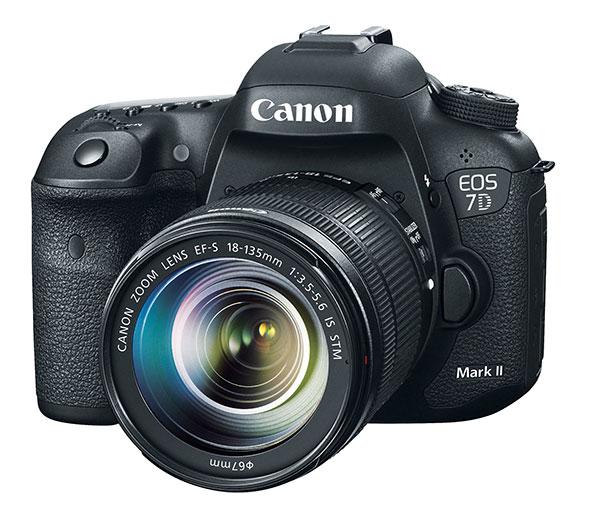"The 7D II’s sensor, however, is still APS-C-sized – not full frame – like its predecessor."
The predecessor was the 7D, and it was & continues to be an APS-C crop sensor camera!!

Rumors about an alleged 7D Mark II digital SLR from Canon have been swirling for several years and now those rumors have come to fruition. At the photokina show in Cologne, Germany today, Canon finally took the wraps off the 20.2-megapixel Canon EOS 7D Mark II, the long awaited successor to the original 18MP 7D DSLR from 2009.
While the new 7D Mark II resembles that camera – a bit – in both name and design, it’s a completely new beast under the hood. The 7D II’s sensor, however, is still APS-C-sized – not full frame – like its predecessor.

Canon also unveiled three new lenses today, including two EF series lenses ─ the EF 400mm f/4 DO IS II USM super telephoto lens and the EF 24-105mm f/3.5-5.6 IS STM standard zoom lens, along with one EF-S series lens ─ the EF-S 24mm f/2.8 STM wide-angle pancake lens.
The star of today’s Canon announcements – which also saw the introduction of the PowerShot G7 X premium compact camera – is clearly the much anticipated 7D Mark II. Does it live up to the protracted build-up? That’s hard to say since we’ve only seen prototypes of the camera though expect to get some hands-on time with working 7D II models at photokina later today.

In the mean time, here’s a rundown of key features for the 7D II, which goes on sale in November 2014 (yes, you’ll have to wait a bit longer still) for $1,799 (body only), and $2,149 bundled with an EF-S 18-135mm f/3.5-5.6 IS STM lens.
Canon EOS 7D Mark II Features
• Newly developed, 20.2 megapixel APS-C Canon CMOS sensor
• Dual Digic 6 image processors (a Canon first)
• Burst shooting speed at 10 frames per second
• At 10 fps, camera’s buffer can capture up to 31 RAW images or 1,090 Large Fine JPEGs consecutively
• 65-Point, all Cross Type autofocus (AF) system (a Canon first) with -3 EV sensitivity for low light shooting
• AI Servo AF III autofocusing algorithm similar to what’s in the 1D X pro DSLR
• ISO range of 100–16000 for both still and video (expandable to ISO 51,600)
• Enhanced version of Canon’s EOS iTR (Intelligent Tracking and Recognition) AF, which recognizes subjects based on face and color detection using the new AE system, and can track subjects using all 65 AF points.
• EOS Scene Detection system features new 150,000-pixel RGB+IR 252-zone metering sensor for enhanced precision
• Built-in intervalometer and bulb timer for time-lapse recording
• Shutter durability rate at up to 200,000 cycles
• Dual Pixel CMOS AF (DAF) technology
• Dual card slots for SD/SDHC/SDXC and CF memory cards
• Revamped Intelligent Viewfinder with 100% field of view
• 3-inch Clear View II LCD monitor (approximately 1,040,000 dots) on back
• Built-in GPS receive with digital compass
• Pop-up flash
Premium Video Features
Like it’s predecessor, the 7D Mark II comes loaded with a number of pro-level movie-making features including 1080p Full HD or 720p HD video at up to 60p, letting you do slow-motion capture at full resolution in either ALL-I or IPB codecs with optional embedded time code. The 7D II’s Dual Pixel CMOS AF lets you choose etiher Movie Servo AF Speed and Movie Servo AF Tracking Sensitivity when capturing video. Budding DSLR cinematographers can also choose between .MOV and .MP4 recording formats for flexibility. The EOS 7D Mark II camera’s mini HDMI port can also be used to record uncompressed Full HD video to external recorders.
The 7D Mark II also has a stereo microphone port and outputs stereo audio via the camera’s mini-HDMI port. The camera has a headphone jack for real-time audio monitoring, along with a silent control feature that lets you adjust audio levels during recordings.
Three New Lenses
Canon also introduced three new lenses today: the EF 400mm f/4 DO IS II USM super telephoto lens, EF 24-105mm f/3.5-5.6 IS STM standard zoom lens, and the EF-S 24mm f/2.8 STM wide-angle pancake lens.
Th EF 400mm f/4 DO IS II USM ($6,899) super telephoto lens features gapless dual-layered diffractive optical (DO) elements that are designed to help improve optical performance while keeping approximately the same size and weight as its predecessor. The lens has Canon’s Optical Image Stabilization with up to four shutter speed steps of correction. There are also three IS modes ─ standard, panning and during exposure only. The Image Stabilizer on this now does not have to be disabled when shooting with a tripod, which should be a real time-saver. It goes on sale in November 2014.

The new EF 24-105mm f/3.5-5.6 IS STM ($599) lens is Canon’s first EF-series zoom lens for full-frame sensor cameras to include a lead screw-type stepping motor (STM) designed to provide virtually silent AF while shooting video. The Optical Image Stabilizer also offers up to four shutter speed steps of correction, and the lens featurs two aspheric lenses and a UD lens. It ships in December 2014.
The relatively inexpensive EF-S 24mm f/2.8 STM ($149) lens is Canon’s slimmest and lightest EF-S lens yet. This “pancake” style lens features STM technology an aspheric lens element and coating to to minimize ghosting and flare. The lens’ seven bladed aperture is designed to deliver soft backgrounds – aka bokeh -- while its Electro-Magnetic Drive aperture mechanism uses a micro-stepping driver control for quieter operation, which should come in handy when shooting video. The lens goes on sale in November 2014.

"The 7D II’s sensor, however, is still APS-C-sized – not full frame – like its predecessor."
The predecessor was the 7D, and it was & continues to be an APS-C crop sensor camera!!